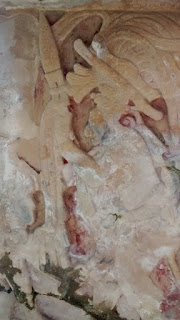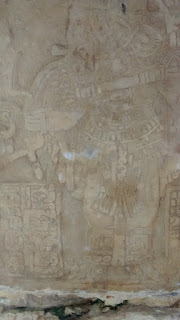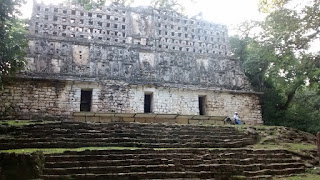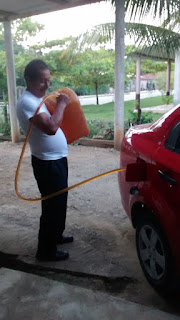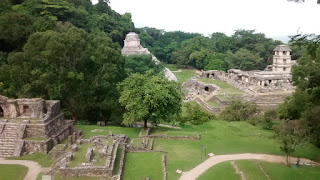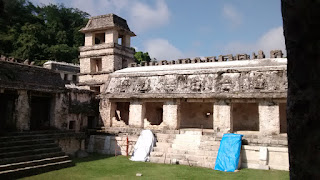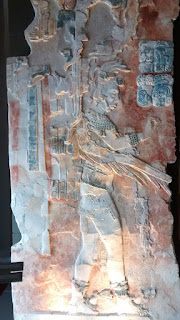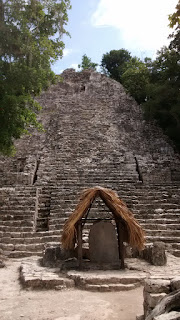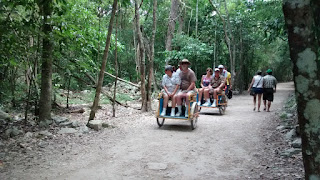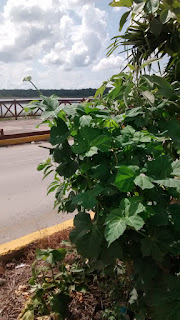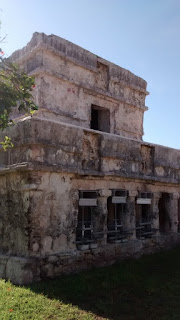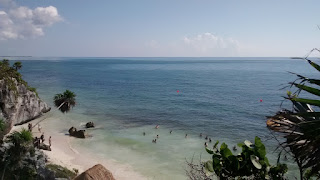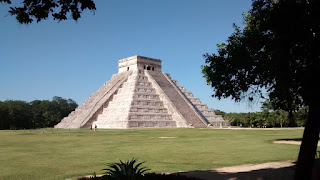 |
| El Castillo [The Castle] of Chichen Itza! |
Chichen Itza. One of the Seven Wonders of the Modern World. An astonishing example of Mayan architecture. A must see if you travel to Cancun or Merida. (It's approximately half way in-between the two cities.)
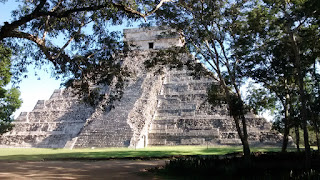 |
| El Castillo [The Castle] |
On Sunday, I was making really good time. I'd already visited Tulum and Coba. If I arrived in time to my hotel at Chichen Itza, I was excited to run in for a quick tour before in-depth exploration on Monday. My plan had been to stay at one of the hotels close enough to walk into the entrance. It was outrageously expensive; but, who knows when I'll get to visit Chichen Itza again? I parked my car on the hotel's former tennis court now parking lot at 4 pm. Ducking into the hotel's reception, there was a group of four senior citizens in front of me. The receptionist was busy getting them checked in and bringing out refreshing jamaica (hibiscus juice) for them to drink. I asked another employee when Chichen Itza closed. He said 5; and, I ran out the door to put my backpack in my car and walked to the park's back entrance. Here, my luck ran out. Even though the park is open until 5 pm, the back entrance closes at 4. No amount of cajoling the guard or his manager got me in. At this time, I also found out that I could not enter the park via this entrance to see the audio/video show that night, either. Instead, I would have to drive around to the main entrance just before the town of Piste. So much for my grand plan.
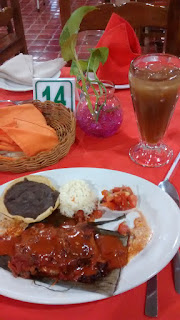 |
| Dinner at Las Mestizas |
I dejectedly walked back to the hotel. Inside, the receptionist told me that he had two bookings for me and would have to charge me for both. After we looked at his two print-offs, we discovered that they had the same booking number, just in different places. At least that was easy to clear up! To the side of the reception desk, there was a big poster about the Chichen Itza Light & Sound Show stating that the hotel had free tickets. I asked the receptionist about getting a ticket. He checked into the reservation system; and, there were no more spaces open. Unbeknownst to me, in 2015, the park is trying a different type of ticketing for the nightly show. Instead of it being part of the park entrance ticket, it is now free. However, tickets must be
reserved online, or through your hotel. The receptionist gave me a ticket anyway and instructed me to go to the park around 7:45 to see if there were open spaces.
 |
| Papaya dessert with cheese |
There was nothing left to do but to go into town (Piste) for a bit of dinner. Dinner was at Las Mestizas. It was empty except for two older female tourists and myself. I tried the chicken made in a banana leaf with a large glass of tamarind juice. Since there was still plenty of time, I ordered the papaya dessert as well. It was certainly different.
 |
| Waiting for "Nights of Kulkulkan" to begin |
Driving to the main entrance of the museum, I paid 30 pesos to park. Then, I joined the queue next to the ATM for all of us without reservations. In front of me a dad played with his daughter. To our right, there was a long line of people who had reservations. It was plenty of time to get in some reading on my phone. Finally, at 8 pm, the gate opened; and, all the reservation holders filed through. Then, it was our chance! We were instructed to sit in the chairs at the back. We filed through and walked to the chairs set-up in front of the pyramid. Even with everyone seated, at least a quarter of the seats were empty. Around 8:30, a welcome was given in Spanish and English. Then, the show began. It was spectacular! "
Nights of Kulkulkan" makes good use of the pyramid's design to project a brief story of the Mayan in dazzling color. It included both Mayan legends about how the world began as well as providing information on the pyramid of Chichen Itza. However, the presentation is only in Spanish without any translation or subtitles. It was so great that I was able to get a chance to see the show! I went back to my hotel energized and excited to explore the park the following day.
 |
| Back entrance at "Zona Central" |
The next day, I enjoyed a delightful breakfast at the hotel. The hotel rooms are all facing in toward the courtyard. On one side of the courtyard is the pool. On the other side is the restaurant. I enjoyed eating on a table in the courtyard, listening to all the unknown bird calls. Since hotel checkout wasn't until 1 pm, after breakfast, I left my room disorganized with a "Do Not Disturb" sign and headed toward the park's back entrance. There were signs posted in the ticket office on rates (between 150 pesos for nationals & residents to 224 pesos for foreigners). However, at least the rate they charged me and the couple behind me was much less, 76 pesos per person. After waiting for a tour group to all get their tickets punched, finally, I was in
Chichen Itza Archeaological Zone! Walking down the trail with a couple from Boston, we came to the map of the site. A tour group stood in front of it, listening as their guide pointed out different sites. Another guide stood to the side. The Boston couple and I struck up a conversation with this second guide, asking for his recommendations of what we should see first. He suggested visiting the pyramid first and pointed us to the appropriate path to take. While I headed to the pyramids, the couple decided to take another path to the left.
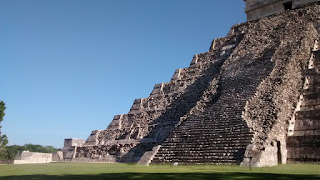 |
| El Castillo [The Castle] |
The guide's suggestion was wonderful because there was no one yet at the pyramid at 8:30 am in the morning. I was able to take some beautiful photos. Walking through the grass, the buzz of bees droned around me. Looking down, the bees were everywhere, humming through the green grass. Even this early in the morning, the sun was scorching. I was thankful for both my sunblock and hat! I didn't stay long in the open by the great Castle.
 |
| Cenote Sagrada |
Next stop was the Cenote Sagrado, or Sacred Well. A cenote is a sinkhole. While there are several in the Yucatan Peninsula that are now open for swimming, this one is not. Below, the water was a greenish blue. Previously, this cenote had been used by the Maya to offer sacrifices; and, many artifacts have been pulled from it. Today, it rests in pristine beauty for tourists to view.
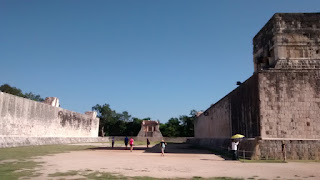 |
| The ball court of Chichen Itza |
 |
| Side of the ball court |
Next stop, the ball court. It is immense! According to the signage, it is the largest ball court in
Mesoamerica. (Mesoamerica is approximately from the border with Texas to Belize.) At 135 meters, it is longer than a football or soccer field. Along each side, the first meter or so is capped with the long snake. Its head is the same as the heads at the bottom of each staircase of "The Castle". Below the snake carving, the entire side is filled with bas-relief carvings in the stones. It is impressive!
 |
| Platform of skull carvings |
After walking the entire length of the ball court, I walked a past a few standalone platforms. These also had a variety of bas-relief sculptures in surprisingly good condition. However, they were more morbid. One entire platform was covered with carvings of skulls. Another platform had repeated images of warriors holding decapitated heads.
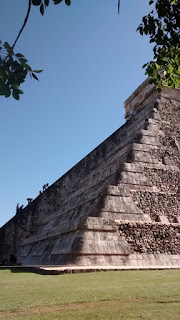 |
| Workers climbing El Castillo |
The sun and heat were starting to get to me. There was a bench in the shade with a good view of The Castle. I sat down to write in my journal about all my impressions of Chichen Itza. As I was staring at The Castle, I saw people climbing up and down it. How exciting! The pyramid is no longer open for visitors to climb. Maybe I had arrived on an exceptional day! I raced over to the pyramid. Everyone behind the rope cordon wore an extra large badge on a lanyard around their necks. I struck up a conversation with one of the guys, asking if the pyramid was open to climb. Unfortunately, the only people allowed up it are park workers. They were preparing for the evenings light and sound show.

My meandering continued past several immense, columned buildings, a small cenote and a smaller pyramid until I arrived at the Observatory. It is a cylindrical building, the only one on the entire site. It's also called the "Caracol" or conch because it has a spiral staircase. Archaeologists hypothesize that it was used for astronomical observations.
 |
| Faces on The Church |
 |
| The Church |
Past the observatory is a building called "The Nunnery". It is another extensive structure! However, the really interesting building at this point was the "Church", a small construction to the side of the nunnery. It has over-the-top ornamentation. Giant faces in the center have large, hooked noses. Behind this building are several buildings facing into a patio area.
The final building to see is the Akab Dzib. There is an arrow pointing down a small trail for both the Hacienda Chichen Itza and Akab Dzib. We couldn't get very close to it. From the trail, it looked rather drab. However, if you stay in the Hacienda Chichen Itza, just past this building is an entrance to your hotel. Unfortunately, those of us in other hotels by the back entrance cannot take this shortcut. Instead, I had to walk back past the Church, Nunnery, Observatory, smaller pyramid and small cenote to return to the back entrance.
After packing up and checking out of my hotel, I was by now quite tired of being hot and sticky for my third day in a row. Just up the road, there is a cenote open for swimming. It's called
Ik-Kil. However, it's not part of the state or national parks and monuments; and, there is no discount for Mexican nationals or residents. 70 pesos gets you in. Then, it's a quick rinse off in their outdoor showers before the guard will let you descend the slippery stone steps to the cenote. Vines hang down to the water from the upper edge. Mini waterfalls spray from the rocks. The water is a clear, deep greenish blue. I climbed down the wooden log ladder into the refreshing water. It felt so wonderful! For once in three days, I didn't feel the heat and humidity. Little black flash swam around us in the water. Floating on my back, I looked up toward the sky. The joyful screams of teenagers playing faded from my ears. For a few moments, it was my own private paradise. What a great way to end my three day weekend!
Travel Notes:
Chichen Itza Archeaological Zone. Open 8 am (more like 8:30 am) - 5 pm. Back entrance closes at 4 pm. Parking at main entrance is 30 MXN. Tickets -- at least 76 MXN (for Mexican nationals and residents). Unable to determine tourist pricing. Free on Sundays for Mexican nationals and residents. To avoid all the vendors and tour groups, get there early.
Nights of Kulkulkan. Free but requires a reservation. Line up starts at 7:30 pm. Entrance to park at 8 pm. Show only delivered in Spanish.
Cenote Ik-Kil. 70 MXN entrance. No discounts. No additional parking fee. Extra fees for renting lockers (30 MXN) and renting life jackets (45 MXN) although neither are required.
Hotel Villas Arqueologicas. My room for two was $58.91 on Booking.com. I paid ~880 MXN at the hotel. Parking included. Breakfast not included and cost between 110 - 130 MXN for all inclusive breakfast.


